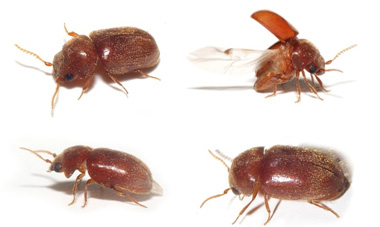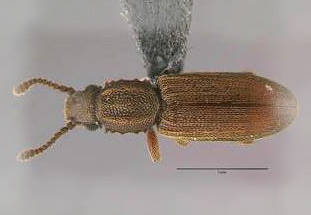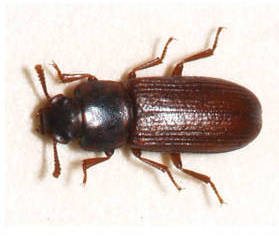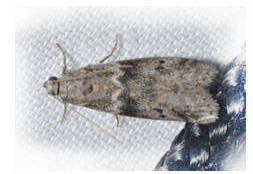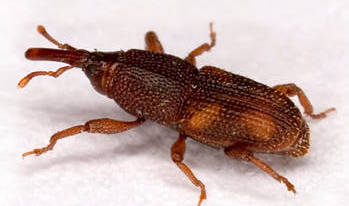Stored product pests
Stored product pests (aka pantry pests) are insects that tend to gather around food often stored in pantries and cabinets, such as flour, dry cereals, spices, candies and chocolate. These pests damage about 10% of the world’s annual production of stored grains.
There are different groups of stored product pests of which the beetles are the largest and most important group.
The moths are the second largest group. There is also the mites and the flies.
Because stored product pests belong to many diverse groups few generalizations are possible. Some can infest food material when they are still in the field, in addition to infesting them while in storage.
The most common stored product pests are often separated into 4 groups based on their feeding habits along with some familiarity with the biology and behavior of stored product pests will greatly aid in the identification of the pest at hand.
Below are different stored product pests mostly encountered:
Cigarette Beetle
As indicated by its common name, the cigarette beetle is a pest of tobacco, both in the refined cigarette packet presentation and also as stored in hogsheads and bales, but is also a pest of oilcake, oilseeds, cereals, dried fruit, sage, flour, and some animal products.
Contact our Entotox office in your region for a pest management and extermination plan.
Merchant Grain Beetles
The merchant grain beetle, is a small, flattened beetle about 2.5mm in length.[1] It is a common, worldwide pest of grain and grain products as well as fruit, chocolate, drugs, and tobacco
Confused Flour beetle
The confused flour beetle (Tribolium confusum), a type of darkling beetle known as a flour beetle, is a common pest insect known for attacking and infesting stored flour and grain. They are one of the most common and most destructive insect pests for grain and other food products stored in silos, warehouses, grocery stores, and homes.[1]
The “confused” in the beetle’s name is due to it being confused with the red flour beetle
Hide/ Leather/ skin beetle
This beetle’s common name comes from hide and skin being the preferred food of adults and larvae. Other common names include larder beetle, hide or leather beetles, carpet beetles, and khapra beetles. It has been widely distributed via the shipping trade and is now found worldwide.
Dermestid beetle, (family Dermestidae), are any of approximately 700 species of beetles (insect order Coleoptera) that at one time were important household pests because the larvae feed on furs, skins, feathers, horn, and hair. Adults are usually brown or black, although some are brightly colored or patterned and are covered with either hairs or scales that easily rub off. They vary in shape from elongated to oval, and range in size from 1 to 12 mm. The wormlike larvae are the only beetle larvae that are covered with hair.
&nbps;
Indianmeal Moths
The Indianmeal moth was given its name after an insect scientist found it feeding on corn meal, also known as Indian meal. It is probably the most important and most commonly encountered pest of storage products found in home and in grocery stores.
The Indianmeal moths like to feed on dried fruits, grains, seeds, nuts, chocolate, candies, bird seed, dog food, powdered milk, dried red peppers and candy.
To prevent from an indianmeal moths infestation, dried food products should be inspected thoroughly for signs of Indian meal moth infestations. Discard infested foods in outdoor trash bins. Clean infested cupboards thoroughly with a vacuum and soap and water. Always Store food in sealed containers.
Mediterranean Flour moth
The Indianmeal moth was given its name after an insect scientist found it feeding on corn meal, also known as Indian The Mediterranean flour moth or mill moth (Ephestia kuehniella)[1] is a moth of the family Pyralidae.[2] It is a common pest of cereal grains, especially flour. This moth is found throughout the world, especially in countries with temperate climates.[3] It prefers warm temperatures for more rapid development, but it can survive a wide range of temperatures.[3]
The Mediterranean flour moth is frequently found in warm places with stored grain products, such as flour mills and bakeries, where it can breed year round. Flour mills have a particular problem with the Mediterranean flour moth because the caterpillars spin silk that clogs machinery. The most effective pest control strategy for this moth is sanitation of facilities and sealing grain containers to prevent infestation, but some pesticides may also be used.
Rice Weevil
The rice weevil (Sitophilus oryzae) is a stored product pest which attacks seeds of several crops, including wheat, rice, and maize. It is considered by many to be the most important stored product pest. The Rice weevil bores a hole into the kernel of the grain and lays an egg, sealing the opening with a gelatinous material. Adults fly from stored grain to infest the new grain crop in the field and the infestation continues through storage.
It has been recorded attacking corn, wheat, rice, beans, nuts, cereals, rye, buckwheat, stored cotton, wheat products of all kinds and grapes. In addition it will feed on apples and pears. Adults can fly and are attracted to lights.
Contact Entotox office in your region for a pest management and extermination plan for stored product pests.




